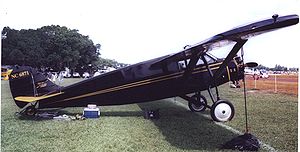Stinson Junior Video - Picture

|
|
Stinson Junior

Picture - Stinson SM-2 Junior of 1928 at the Sun N'Fun show, Lakeland, Florida in April 2007
Role: three/four-seat private civil aircraft
National origin: United States
Manufacturer: Stinson Aircraft
First flight: 1928
Status: some still flying in 2009
Primary user: private owners
Number built: 321
Developed from: Stinson Detroiter
The Stinson Junior was a high-winged monoplane of the late 1920s, built for private owners, and was one of the first such designs to feature a fully enclosed cabin.
Design and development
Stinson Aircraft had introduced their large high-winged six-seat SM-1 Detroiter in 1927. The SM-1 was sold successfully to airlines and other commercial operators, but it was too large to appeal to private owners.
Stinson therefore redesigned the aircraft with shorter span wings, shorter fuselage and a choice of less powerful engines as the SM-2 Junior. The aircraft was a strut-braced high-wing monoplane with a sturdy outrigger undercarriage which was braced against the wing support struts and the initial 110 h.p. Warner Scarab engine was normally left uncowled. The first SM-2 flew in mid-1928 and deliveries commenced that year. Later versions of the SM-2 had higher-powered engines of between 165 h.p. and 225 h.p.
The design was further developed to produce the more powerful and heavier SM-7 and SM-8 models which were full four-seaters and these were also used by commercial firms. The Junior R of 1932 had a deeper fuelage and a low-set stub wing to mount the undercarriage and wing struts.
Operational history
The various Stinson Junior models were in production between 1928 and 1933, being bought by both wealthy private flyers and commercial enterprises. A total of 321 Juniors were built, of which 27 survived in 2001 and several of these were airworthy in private hands.
Variants
(per Simpson, 2001, p. 523-524)
SM-2
Warner Scarab 110 h.p.
SM-2AA
Wright J6-5 165 h.p.
SM-2AB
Wright J5 220 h.p.
SM-2AC
Wright J6-7 225 h.p.
SM-2ACS
floatplane version of the SM-2AC
SM-7A
Wright J6-9 300 h.p.
SM-7B
Wasp Junior 300 h.p.
SM-8A
Lycoming R-680 215 h.p.
SM-8B
Wright J6-7 225 h.p.
SM-8D
Packard diesel 225 h.p.
Junior R
Lycoming R-680 215 h.p. and deeper fuselage
Junior R-2
Lycomong R-680-BA 240 h.p.
Junior R-3
as R-2 with retractable undercarriage
Junior R-3-S
Lycoming R-680-6 245 h.p.
Junior S
Lycoming R-680 215 h.p. with fully cowled engine
Junior W
generally similar to the SM-7B, powered by a Wasp Junior engine
Specifications (SM-2AC)
Data from <Green, 1965, p. 298>
General characteristics
Crew: 1
Capacity: 3 passengers
Length: 29 ft 0 in ( m)
Wingspan: 41 ft 8 in ( m)
Height: 8 ft 3 in ( m)
Wing area: 236 ft² ( m²)
Empty weight: 2,169 lb ( kg)
Gross weight: 3,229 lb ( kg)
Powerplant: 1 x— Wright Whirlwind J6-7 nine-cylinder radial air-cooled, 225 hp ( kW)
Performance
Maximum speed: 135 mph ( km/h)
Cruise speed: 113 mph ( km/h)
Range: 450 miles ( km)
Service ceiling: 22,000 ft ( m)
Rate of climb: 1,200 ft/min ( m/s)
Bibliography
Green, William (1965). The Aircraft of the World. Macdonald & Co (Publishers) Ltd. ISBN none.
Simpson, Rod (2001). Airlife's World Aircraft. Airlife Publishing Ltd. ISBN 1-84037-115-3.
Stinson Junior Pictures
More airplane videos.
Source: WikiPedia